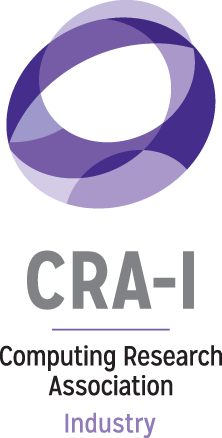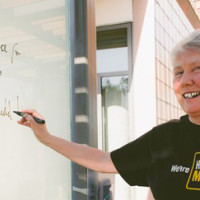CHIMe 2012 Discipline Specific Workshop
The CHIMe 2012 mentoring workshop took place on May 5-6, 2012 in Austin, TX colocated with the CHI 2012 conference. In attendance at the 1.5-day workshop were 30 students (25 from the US, 5 from Canada) and 11 speakers from academia, industry, and government labs. Organizers Ron Metoyer and Manuel Pérez-Quiñones developed this second incarnation after the successful CHIMe 2010 two years ago. Both CHIMe workshops were part of the Discipline Specific Workshops series funded by the CRA-W/CDC alliance. In addition, CHIMe has received extra funding from NSF to support student travel and funding from Microsoft, IBM, and Intel. Microsoft, IBM, Intel, and Google also supported the effort by sending several inspiring speakers and panelists to mentor the attendees.
The workshop began with a series of lightning round introductions, with each participant having up to three minutes to introduce themselves and talk about what they hoped to get out of CHI and CHIMe. Despite some initial hesitation, everyone quickly rose to the occasion and we were all inspired by the variety of interests and connections between each others’ work.
Over the course of the workshop, five speakers gave research presentations on their HCI work, including current and former CRA-W board members Tessa Lau and Cecilia Aragon. Topics included end user programming, designing for prenatal care in rural Kenya, trust in healthcare systems, and career paths in HCI. During the panels, students and panelists interacted over a variety of topics ranging from what topics are hot in HCI, when and why to find summer internships, to comparisons between academia, government, and industry labs. Smaller groups during lunch and breaks discussed more personal topics such as the advisor/student relationship, having a romantic relationship with someone also in the field, and how to approach famous people at the conference.
Participant diversity was a goal in the recruitment of students for the workshop. The organizers particularly targeted women, African-Americans, Latinos, and students with dis-abilities. We also had some international participation via 5 students from Canada. Overall, we had 25 students from the US, 5 from Canada, and 1 remote (due to disability) also from the US. Most of our participants were female (70%), confirming what has been reported in the literature recently, that women are publishing at higher numbers in the human-factors sub-fields of computing. In terms of ethnicity and race, we also had a very diverse group with: 37% African-Americans, 27% Caucasians, 17% Hispanics, 10% Asian-Americans, 3% Native Americans, 7% Other.
US applicants came from California, Oregon, Washington, Iowa, Wisconsin, Illinois, Indiana, Tennessee, Alabama, Georgia, Florida, South Carolina, Virginia, Maryland, Pennsylvania, New York, Massachusetts, and Rhode Island. This distribution seems to reflect the location of well known HCI graduate programs (UCSD, Georgia Tech, Penn State, Virginia Tech, Maryland, Washington) or graduate programs with minority faculty specializing in HCI (Wisconsin-Madison, Oregon State, Clemson, etc.).
By design, the speakers and panelists reflected the diversity in attendees. There were 6 males (including organizers) and 7 females from various ethnic backgrounds including several Latino/Latina and African American participants. These speakers/panelists played a vital role in providing the students with role models, in their field, who understand their issues and who represent active, successful researchers in the CHI community. They provided an excellent professional and social network basis on which the students can begin to build.
One of the main themes of the workshop was how important it is to develop one’s social networks, especially as we prepared to attend the enormous CHI conference in the coming days. Yet even though the conference seems large, the space of HCI researchers is actually fairly small and tightly connected. To illustrate this, one of the organizers pasted several sheets of paper up at the back of the room and asked everyone to draw themselves and their advisors on the chart, with links between advisors/students and paper coauthors. The connectedness of the graph below shows how well connected the field is!





